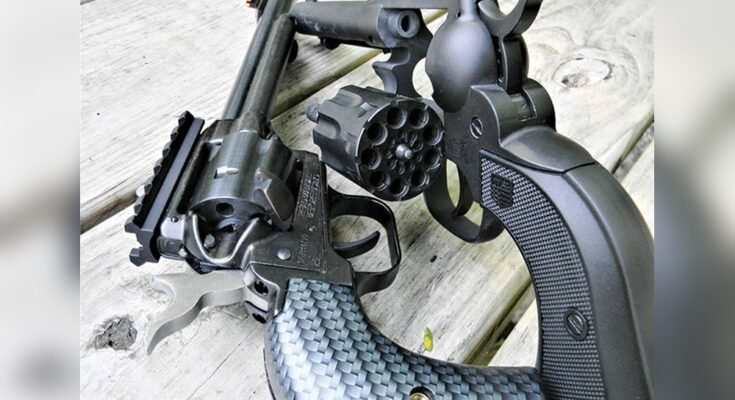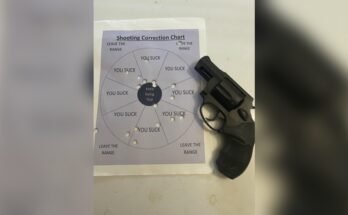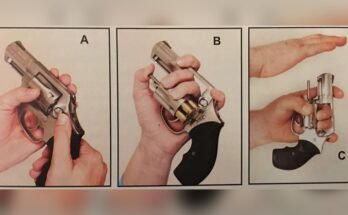When it comes to protecting yourself, choosing the right firearm is crucial. You might be wondering if swing-out cylinder revolvers are a good fit for your self-defense needs.
These guns have a classic look and are known for their reliability, but are they truly effective when seconds count? You’ll discover the strengths and weaknesses of swing-out cylinder revolvers and find out if they can give you the confidence and safety you deserve.
Keep reading to learn what every responsible gun owner should know before making a choice that impacts your security.
Swing-out Cylinder Mechanism
The swing-out cylinder mechanism is a key feature in many modern revolvers. It allows the cylinder to pivot out from the frame. This design makes loading and unloading faster and easier than older revolvers with fixed cylinders.
Understanding how this mechanism works helps to see if swing-out cylinder revolvers suit self-defense needs. The design impacts speed, safety, and reliability, all important for personal protection.
How It Works
The cylinder swings out to the side of the gun frame. This exposes all the chambers at once. Users can quickly remove spent cartridges with an ejector rod. Then, they load fresh rounds into each chamber. After loading, the cylinder swings back into place. The revolver is ready to fire again.
This mechanism is simple and smooth. It reduces the time needed to reload under pressure. Many self-defense revolvers use this design for its ease and speed.
Advantages Over Fixed Cylinders
Fixed cylinder revolvers require removing cartridges one by one. This process is slower and less convenient. Swing-out cylinders let users reload multiple rounds quickly. The ejector rod pushes all empty shells out at once. This feature saves valuable seconds in emergencies.
Swing-out cylinders also make cleaning and maintenance easier. A clean revolver works more reliably. Reliability is crucial for self-defense situations. The design provides a balance of speed and safety. It allows quick action without sacrificing durability.

Reliability In High-stress Situations
Reliability in high-stress situations is crucial for any self-defense firearm. A swing-out cylinder revolver must perform without fail when seconds count. It should function smoothly and withstand tough conditions. Trust in the revolver’s operation builds confidence during emergencies. This trust is essential to handle threats effectively and safely.
Durability And Maintenance
Swing-out cylinder revolvers are known for their strong, simple design. Fewer moving parts mean less chance of failure. The metal frame resists wear and tear, lasting many years. Proper cleaning and lubrication keep the revolver working well. Dirt and grime can cause jams or misfires. Regular maintenance ensures the cylinder swings out freely and locks firmly in place. This reliability reduces worries about malfunctions during critical moments.
Performance Under Pressure
Stress affects how well a person uses a firearm. A swing-out cylinder revolver offers easy handling and quick reloads. The clear cylinder view helps check rounds fast. The trigger pull is consistent, aiding accuracy. The revolver’s simple mechanism reduces chances of mechanical failure. It works smoothly even with sweaty or shaky hands. This dependable performance helps users stay calm and focused.
Firepower And Capacity
Swing-out cylinder revolvers have a unique place in self-defense discussions. Their firepower and capacity are key factors to consider. Understanding these aspects helps you decide if they fit your needs.
Typical Calibers Used
Swing-out cylinder revolvers often use popular calibers. Common choices include .38 Special and .357 Magnum. These calibers offer a balance of power and manageable recoil. Some models also chamber .44 Magnum for more stopping power. The choice of caliber affects both performance and comfort during use.
Number Of Rounds
Most swing-out cylinder revolvers hold between five and seven rounds. Six-shot cylinders are the most common. This capacity is lower compared to many semi-automatic pistols. However, revolvers are known for reliability and ease of use. Each shot counts, making shot placement important.

Ease Of Use And Handling
Swing-out cylinder revolvers offer a unique experience in handling and ease of use. Their design affects how quickly and comfortably you can operate them. Understanding these factors helps decide if they suit self-defense needs.
Reload Speed
Swing-out cylinder revolvers allow the cylinder to swing out to the side. This design makes reloading faster than older top-break or fixed-cylinder models. You can eject spent cartridges all at once with an ejector rod. Then, place fresh rounds quickly into the chambers. Still, speed depends on practice and the type of speed loader used. Reloading is slower than semi-automatic pistols but faster than traditional revolvers.
Ergonomics And Weight
These revolvers often have a balanced weight that feels steady in hand. Their grip usually fits well for most hand sizes. This helps with aiming and control during shooting. They tend to have fewer parts to worry about, reducing complexity. The weight can absorb recoil, making shots more comfortable. However, heavier models might tire the user in long holds. Overall, their shape and weight promote good handling for self-defense.
Comparison With Semi-automatic Pistols
Swing-out cylinder revolvers offer simplicity and reliability in self-defense. Semi-automatic pistols usually hold more rounds and reload faster. Choosing depends on personal comfort and skill with each type.
Swing-out cylinder revolvers and semi-automatic pistols both serve self-defense purposes. Each has unique features that affect performance and user experience. Understanding these differences helps choose the right firearm for personal protection.
Semi-automatic pistols usually hold more rounds. They reload faster using magazines. Revolvers have fewer rounds but simpler mechanisms. This simplicity can mean fewer jams or malfunctions. The choice depends on comfort, training, and situation.
Pros And Cons
Revolvers offer reliability and easy use. Their simple design means fewer parts can break. They work well without much maintenance. Reloading is slower and requires more practice. Limited capacity means fewer shots before reloading.
Semi-automatic pistols carry more bullets. They reload quickly with spare magazines. Some models have better sights and grips. They need more cleaning and care. Jams or misfires happen more than with revolvers. Pistols require more skill to operate smoothly.
Situational Effectiveness
Revolvers are best in close, quick-defense situations. They fire without worrying about slide or magazine issues. Their ease of use suits beginners or high-stress moments. Pistols excel in longer fights needing more shots.
Pistols fit well in tactical or law enforcement roles. They allow quick reloads under pressure. Revolvers may slow down in extended encounters. Both firearms can protect well with proper training.
Expert Opinions And Recommendations
Experts share many views about swing-out cylinder revolvers for self-defense. Their opinions help readers understand the pros and cons. These insights come from law enforcement officers and self-defense enthusiasts. Both groups have practical experience with firearms and safety.
Law Enforcement Views
Many officers respect the reliability of swing-out cylinder revolvers. They trust these guns because they rarely jam or misfire. Some agencies still use them as backup weapons. Officers often praise their simple design and ease of use. The revolver’s quick reload capability is valued during high-pressure situations. However, some prefer semi-automatic pistols for higher ammo capacity. Training and personal comfort also influence their choices.
Self-defense Enthusiast Perspectives
Self-defense fans appreciate revolvers for their simplicity and dependability. They find the swing-out cylinder design easy to reload fast. Many believe revolvers offer a better safety margin under stress. Some users prefer fewer moving parts, reducing maintenance needs. Others like the classic feel and solid build. Critics argue about the lower bullet capacity compared to pistols. Personal preference and practice play big roles in their recommendations.
Legal And Practical Considerations
Choosing a swing-out cylinder revolver for self-defense involves important legal and practical aspects. Understanding these factors helps ensure responsible and effective use. Knowing the laws and how to handle the firearm safely protects both the user and others.
Concealability
Swing-out cylinder revolvers tend to be bulkier than semi-automatic pistols. Their size can make hiding them under clothing more difficult. Bulky guns may print through clothes, making them visible to others. This issue affects legal carry in many places. Choosing a smaller model improves concealability. The right holster also helps keep the gun discreet. Concealability matters for everyday carry and quick access.
Training Requirements
Using a swing-out cylinder revolver requires practice. Reloading speed is slower compared to semi-automatics. Users must learn to reload quickly under stress. Accurate shooting and trigger control are vital skills. Regular practice builds confidence and muscle memory. Training reduces the risk of mistakes during emergencies. Knowing how to clear malfunctions safely is also important. Consistent training ensures readiness for self-defense situations.

Frequently Asked Questions
Are Swing-out Cylinder Revolvers Reliable For Self-defense?
Yes, swing-out cylinder revolvers are highly reliable due to their simple mechanism. They rarely jam and offer consistent performance under stress, making them a trusted choice for self-defense situations.
How Fast Can You Reload A Swing-out Cylinder Revolver?
Swing-out cylinder revolvers allow relatively quick reloading by swinging the cylinder out and ejecting spent cartridges. With practice, reload times can be competitive, though generally slower than semi-automatic pistols.
Do Swing-out Cylinder Revolvers Have Enough Stopping Power?
Yes, swing-out cylinder revolvers chamber powerful calibers like. 38 Special and. 357 Magnum. These calibers provide sufficient stopping power for effective self-defense in most scenarios.
Are Swing-out Cylinder Revolvers Easy To Use For Beginners?
Absolutely, swing-out cylinder revolvers are simple to operate with minimal controls. Their straightforward design makes them an excellent choice for beginners learning self-defense firearms.
Conclusion
Swing-out cylinder revolvers offer reliability and ease of use. They hold several rounds and reload quickly. Their design suits many self-defense needs. But they may not fit every situation or user. Training and practice improve handling and safety. Choose a firearm that feels right and works best.
Safety and confidence come first in self-defense decisions. Consider your comfort and skill before deciding. Swing-out cylinder revolvers remain a solid, simple choice.



